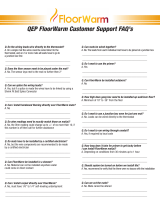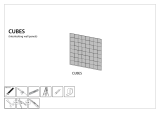
Electrical Planning
The power supply to the Floor Heating
System and the control device will be located
at the same point in the room and indicated
on your plan. If this location has changed, call
WarmlyYours to determine if this will require
a new Installation Plan. The lead wire is 15’
long. You can relocate the control device as
long as your leads reach the new location.
The thermostat requires a deep single or a
double gang box with a single gang mud ring
and should be positioned in a convenient
place for easy access. From the gang box,
two sets of wires will go to the oor:
Set 1) The 120-volt or 240-volt cold lead
wires that power the system
Set 2) The low voltage sensor wire if a
SmartStat or EasyStat thermostat is
being installed.
Some local electrical codes require the low
voltage and/or 120-volt wires above the oor
to be installed in conduit. The low voltage
sensor wire must not be placed in the
same conduit as the 120-volt or 240- volt
power supply. The portion of the cold lead
that is installed in the oor will be directly
covered with thin-set cement or ooring
adhesive.
All lead wires will travel back to the control
location (either directly or through a Relay
Contactor) AND MUST NOT CROSS OR
COME IN CONTACT WITH THE HEATING
ELEMENT.
Check the Ohms reading of the sensor wire
before and after installation to make sure it has
not radically changed. Most sensor wires have
Ohms readings of 8,000 to 20,000 and your
OHM meter must have a 20kohm setting for this
measurement.
Prepare the Suboor
Inspect the suboor surface carefully.
Remove all debris and grind any sharp edges
of cracks. It is important to remove any sharp
edges or pointed objects that might damage
the Heating Element.
Cement Suboors -
Insulate for Heat Retention
We strongly recommend adding a layer
of insulation to the concrete slab prior to
installing the oor heating system. Secure
the insulation to the suboor before installing
the oor heating system. The insulation will
increase the efciency of the system and will
ease placement of the cold lead.
Expansion joints require special
consideration. Heating panels cannot cross
these joints and your Installation Plan should
accurately indicate all joints. If your Installation
Plan does not match your suboor, contact
WarmlyYours to have a new plan designed.
Cementboard Suboors
Remove all debris, staples and nails. Repair
any loose boards and sand the edges of any
boards that are at different elevations. First
apply a 1/8” to 1/4” layer of thin-set cement
and let it dry.
Mudbed Suboors
The Heating Roll(s) are always installed on
top of the Mudbed in the thin-set used to
adhere the tiles.
It is advised to prepare the suboor as you
would for any conventional installation along
the Tile Council of America Guidelines.
Once installed over the sub-oorings
described, at least 1/4 in. of thin-set or mortar
type cement/adhesive material is to be
installed over the heating panel. The ooring
materials that may be installed on top of the
cement/adhesive material cannot have an
insulation value greater than R-1.
Mark the Floor
Using a suitable pen, and referring to the
Installation Plan provided, mark off areas on
the oor where permanent/heavy xtures will
rest. (Cabinets, toilet base, etc.)
Mark the position of the sensor (if one is to
be used) as well as the planned route of the
cold lead wires and sensor wire (if used).
Please note diameter of cold lead and plan
accordingly.
Indicate where the Heating Roll(s) will need
to be cut and the Fiberglass Mesh will be
removed to customize the roll(s) with ips,
turns and where freeform spaces will be
located as indicated on your Installation Plan.
Refer to Page 6 to understand how to
customize and alter the Heating Panels with
ips, turns and freeform spaces.
Refer to Page 9 to develop an understanding
of where the Heating Panels need to be
placed in relation to permanent xtures and
trafcked areas.
Mark the Roll
On the Heating Roll(s), mark the location for
the planned cut and turns and the length of
the free form cuts. Do this from the beginning
to the end of the roll; this is the last time
you can make sure that the total of all panel
lengths on your Installation Plan is the same
as the length of the roll you received.
If there are any changes or discrepancies
with the Installation Plan, you will be able
to choose different locations for the cut-&-
turns, but the reference marks on the roll will
help you to always know if you are effecting
turns a few inches ahead-or-behind what was
designed on the Installation Plan. Remember
that if you extend 4 panels by 3”, at the end
you will be missing a 1’ length of Heating Roll.
Plan any deviation from the Installation Plan
accordingly.
IMPORTANT
Careless use of tools and excessive
trafc during the next few steps is
the leading cause of damage to the
Heating Element. Never drop or bang
a tool on the Heating Element.
Minimize walking on the Heating
Elements and remember that when
rising from a kneeling position, toecaps
may exert too much uneven pressure
on the elements.
We recommend the use of thick scraps
of cardboard or carpeting squares to
reduce the risk of damage.
Make sure that everyone involved
in the installation or performing
other work in the space during the
installation process is aware of the
extra care needed to protect the
Heating Element.
9
Installer’s Guide
STEP 1 STEP 2 STEP 3
STEP 4
STEP 4 cont.
STEP 5























